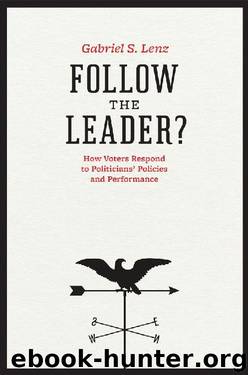Follow the Leader?: How Voters Respond to Politicians' Policies and Performance (Chicago Studies in American Politics) by Gabriel S. Lenz

Author:Gabriel S. Lenz [Lenz, Gabriel S.]
Language: eng
Format: epub
Publisher: University of Chicago Press
Published: 2013-01-29T08:00:00+00:00
Did this learning continue to lead hawks to shift away from Carter? Although learning that Carter was a dove appeared to matter when Carter really was becoming more dovish (January to June), learning that Carter was comparatively more dovish than his opponent seems less likely to have mattered when Carter was in fact shifting to a more hawkish position (June to September). The possible reason, which I spelled out for the European integration case in chapter 5, is that individuals who really did care about defense had, by September, probably already come to a conclusion about Carter’s position on defense—presumably that he was less hawkish than Reagan. So individuals who were coming to see Carter as a dove during the summer were probably the kind of people who did not care much about defense. The fact that they were coming to see him as a dove during a time when he was actually becoming more hawkish makes it even more likely that they did not care much about defense. Consequently, this learning seems unlikely to have affected their views about the candidates.
A similar argument applies to priming effects. By the summer, the kind of person who cared enough about defense policy for it to influence his or her vote had probably already determined an appropriate weight to place on the issue and would no longer be likely to change it.
To test whether this learning mattered between June and September, figure 7.9 presents a (partial residual) scatterplot, showing change in support for Carter and Reagan by June defense-spending attitudes. (Equation 10 in the appendix presents the model behind the scatterplot.) It does so for the 24 percent of the sample who, from June to September, came to see Carter as more dovish than Reagan. Since vote choice is not available in the June wave, I instead measure support for the candidates in June and September using the comparative feeling thermometers (rescaled to vary between 0 and 100). As figure 7.9 shows, we see no evidence of changing candidate evaluations among respondents who learned that Carter was more dovish than Reagan; hawks did not become more supportive of Reagan versus Carter and defense moderates did not become less supportive. In fact, the figure shows surprisingly little change in evaluations among any of the groups. A similar test that searches for priming effects, conducted only among those who already knew that Carter was more dovish than Reagan, likewise reveals no effect. Further analysis also fails to find these effects with the two-wave or three-wave tests. Contrasted with the presence of learning-induced judgments between January and June, the absence of such judgments between June and September is surprising. It is consistent, however, with the idea that such learning fails to influence people who learn late in campaigns, probably because they don’t care a great deal about the issue. (If they did, they probably would have learned earlier.)9
Download
This site does not store any files on its server. We only index and link to content provided by other sites. Please contact the content providers to delete copyright contents if any and email us, we'll remove relevant links or contents immediately.
The Secret History by Donna Tartt(18247)
The Social Justice Warrior Handbook by Lisa De Pasquale(11965)
Thirteen Reasons Why by Jay Asher(8482)
This Is How You Lose Her by Junot Diaz(6466)
Weapons of Math Destruction by Cathy O'Neil(5865)
Zero to One by Peter Thiel(5512)
Beartown by Fredrik Backman(5375)
The Myth of the Strong Leader by Archie Brown(5252)
The Fire Next Time by James Baldwin(5035)
How Democracies Die by Steven Levitsky & Daniel Ziblatt(4973)
Promise Me, Dad by Joe Biden(4916)
Stone's Rules by Roger Stone(4876)
100 Deadly Skills by Clint Emerson(4705)
A Higher Loyalty: Truth, Lies, and Leadership by James Comey(4569)
Rise and Kill First by Ronen Bergman(4555)
Secrecy World by Jake Bernstein(4411)
The David Icke Guide to the Global Conspiracy (and how to end it) by David Icke(4403)
The Farm by Tom Rob Smith(4335)
The Doomsday Machine by Daniel Ellsberg(4255)
